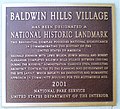Baldwin Hills Village | |
 Village Green neighborhood sign located at the intersection of Obama and Hauser Boulevards | |
| Location | Los Angeles, California |
|---|---|
| Coordinates | 34°01′11″N118°21′39″W / 34.01972°N 118.36083°W |
| Area | 64 acres (26 ha) |
| Built | 1942 |
| Architect | Clarence Stein; Reginald D. Johnson |
| Architectural style | Modern Movement |
| NRHP reference No. | 93000269 |
| LAHCM No. | 174 |
| Significant dates | |
| Added to NRHP | April 1, 1993 [1] |
| Designated NHLD | January 3, 2001 [2] |
| Designated LAHCM | May 4, 1977 |
Village Green, originally named Baldwin Hills Village, is a neighborhood at the foot of Baldwin Hills, within the city of Los Angeles, California. Village Green consists of a large condominium complex that is both a Los Angeles Historic-Cultural Monument and a National Historic Landmark. Designed in the late 1930s and completed by 1942, it is one of the oldest planned communities of its type in the nation. [3] Village Green was named by The American Institute of Architects as one of the 100 most important architectural achievements in U.S. history. [4]







